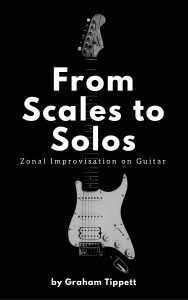
If you ask anyone who’s been playing guitar for a while how to turn scales into solos, you’ll likely get a variety of answers. They’ll tell you to learn licks, work on your arpeggios, even learn your favorite players’ solos note for note. While this is all good advice, I’ve had some particularly stubborn students that wanted to go beyond that; they wanted to be able to improvise using any scale up and down the fretboard, but at the same time break free from those deeply-ingrained scalar lines and patterns. It was then that I suggested zonal improvisation; by working in reduced areas of the neck with specifically designed patterns, they were soon able to create melodic, flowing lines that didn’t sound at all like scales–they sounded like real music.
What is Zonal Improvisation?
Zonal Improvisation is the approach you’ll find in this book. We dissect 15 of the most common scales, beyond the pentatonics, and break them down into zones in commonly used areas of the fretboard. which can then be practiced either by scale or by fretboard zone.
The objective of this book then is to provide a structured reference to make the transition from playing scales to playing, improvising and creating musical lines when soloing. It’s aimed at the intermediate to advanced guitarist looking to be able to improvise confidently and freely on the instrument in a wide variety of styles. It is also aimed at guitarists that want to move beyond rote pentatonic/blues soloing and incorporate other scales and modes into their playing, as well as building up a vocabulary to solo fluently over chord changes using the zonal improvisation approach and 3 distinct methods.
Method 1
The first method involces practicing a variety of scales in one zone. For this you could choose three or so different scales and practice them all in the zone of your choice. This gives you the insight you don’t get from rote drilling scale patterns, as you begin to see the differences between scales and gain the ability to change between scales on the fly. This is covered in the first section of diagrams in this book.
Method 2
The second method is by practicing a single scale in all its zones. This will give the freedom to move up and down the fretboard in any given tonality, and above all, without getting lost. This is covered in the second section of this book, so that you don’t have to be constantly finding pages.
Method 3
Another thing you can do is to focus on the colored notes (the arpeggio) and practice blending these notes with the other defining notes in the scale; for example, when practicing the Lydian Mode, you could play the major 7 arpeggio and incorporate the #4, or with the Phrygian Mode you could play the m7 arpeggio with the b2.